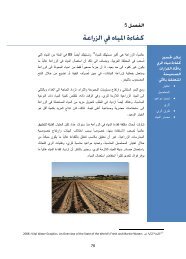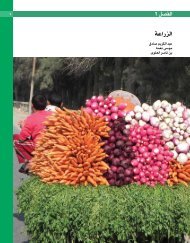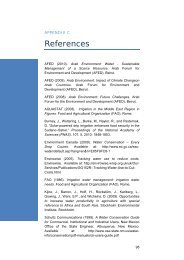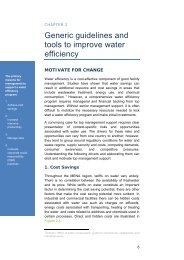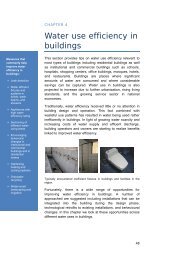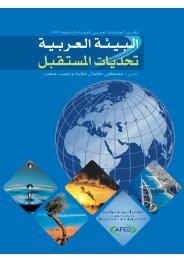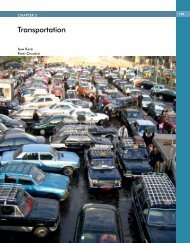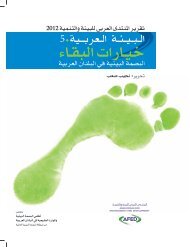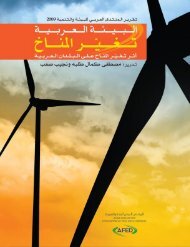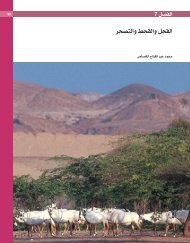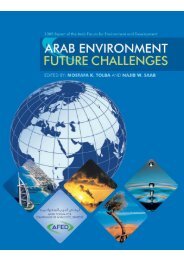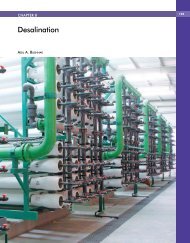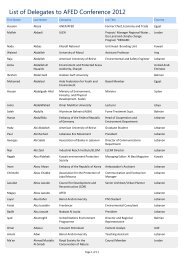Impact of Climate Change on Arab Countries - (IPCC) - Working ...
Impact of Climate Change on Arab Countries - (IPCC) - Working ...
Impact of Climate Change on Arab Countries - (IPCC) - Working ...
You also want an ePaper? Increase the reach of your titles
YUMPU automatically turns print PDFs into web optimized ePapers that Google loves.
106<br />
CHAPTER 8<br />
ECOSYSTEMS AND BIODIVERSITY<br />
(NOAA/NESDIS, 2009). Some areas such as<br />
the lower secti<strong>on</strong> <str<strong>on</strong>g>of</str<strong>on</strong>g> the Red Sea and southern<br />
secti<strong>on</strong> <str<strong>on</strong>g>of</str<strong>on</strong>g> the Gulf have shown an increase<br />
between 1 to 1.5o C. Other areas have displayed<br />
lower but still significant increases between 0.5 to<br />
1o C such as the upper secti<strong>on</strong> <str<strong>on</strong>g>of</str<strong>on</strong>g> the Red Sea,<br />
Mediterranean Sea, Gulf <str<strong>on</strong>g>of</str<strong>on</strong>g> Oman and the<br />
<strong>Arab</strong>ian Sea. Increases in temperatures will also<br />
significantly affect biodiversity al<strong>on</strong>g sandy<br />
beaches and coastal sand dunes; for example<br />
marine turtles that use the beaches <str<strong>on</strong>g>of</str<strong>on</strong>g> Bahrain,<br />
Leban<strong>on</strong>, and Oman for nesting will be affected<br />
significantly as an increase in soil temperature<br />
will affect the ratio <str<strong>on</strong>g>of</str<strong>on</strong>g> females and males and thus<br />
have irreversible c<strong>on</strong>sequences <strong>on</strong> the survival <str<strong>on</strong>g>of</str<strong>on</strong>g><br />
the species in these regi<strong>on</strong>s. Wetlands may be<br />
am<strong>on</strong>g the most sensitive ecosystems in the <strong>Arab</strong><br />
world due to significant impacts <str<strong>on</strong>g>of</str<strong>on</strong>g> climate<br />
change that can be induced from even small<br />
degrees <str<strong>on</strong>g>of</str<strong>on</strong>g> change in the amount and seas<strong>on</strong>ality<br />
<str<strong>on</strong>g>of</str<strong>on</strong>g> rainfall and evaporati<strong>on</strong>.<br />
High altitudes which provide refuges for many<br />
specialized species and niche ecosystems will<br />
undoubtedly witness distributi<strong>on</strong> shifts and in<br />
some cases disappearance <str<strong>on</strong>g>of</str<strong>on</strong>g> species. Two c<strong>on</strong>iferous<br />
tree species, the cedar <str<strong>on</strong>g>of</str<strong>on</strong>g> Leban<strong>on</strong> and the<br />
silician fir reach their southernmost distributi<strong>on</strong><br />
limit in Leban<strong>on</strong> and their distributi<strong>on</strong> range will<br />
recede with increasing temperature to higher latitudes<br />
and altitudes in the regi<strong>on</strong>. Similarly the<br />
Juniper woodlands in Saudi <strong>Arab</strong>ia which are<br />
currently c<strong>on</strong>centrated in a narrow belt about<br />
7,600 square kilometres in size at very high altitudes<br />
ranging between 2000 and 3000 m will be<br />
significantly affected by climate change (Nati<strong>on</strong>al<br />
Report to the CBD). This impact has been noted<br />
whereby decreased humidity and rainfall has<br />
impacted juniper trees in the mountains <str<strong>on</strong>g>of</str<strong>on</strong>g> Jibal<br />
Ash-Sharah in southern Jordan and Hijaz<br />
Mountains in Saudi <strong>Arab</strong>ia; the tips <str<strong>on</strong>g>of</str<strong>on</strong>g> these trees<br />
are drying up and seed regenerati<strong>on</strong> has<br />
decreased (Al Eisawi, unpublished).<br />
Predicti<strong>on</strong> studies made in other parts <str<strong>on</strong>g>of</str<strong>on</strong>g> the<br />
world suggest that climate change will make it<br />
difficult for species thriving in unique microclimatic<br />
refuges to persist; in analogy to these predicti<strong>on</strong>s<br />
it is believed that species adapted to heat<br />
and drought and with broad distributi<strong>on</strong> ranges<br />
in the <strong>Arab</strong> world will displace specialized species<br />
thriving in unique habitats and thus will cause<br />
them to lose all suitable climate space (Rivedi et<br />
al., 2008). For example, predicti<strong>on</strong> models suggest<br />
that in South Mediterranean countries,<br />
mountain regi<strong>on</strong>s would experience a mean <str<strong>on</strong>g>of</str<strong>on</strong>g><br />
62% species loss and turnover showing a major<br />
change in floristic compositi<strong>on</strong> in time (Thuiller<br />
et al., 2005a). Furthermore, modelling studies<br />
predict that species tolerant to aridity will be the<br />
most stable and c<strong>on</strong>serve their initial habitats<br />
and/or expand to new suitable habitats while<br />
species with narrow tolerance to higher temperatures<br />
would lose large proporti<strong>on</strong>s <str<strong>on</strong>g>of</str<strong>on</strong>g> habitats<br />
(40-60%) or migrate up slope towards new<br />
potential habitats if this is geographically available.<br />
Therefore, in c<strong>on</strong>trast to species comm<strong>on</strong>ly<br />
adapted to heat and drought in desert and<br />
semi-desert biomes, the persistence <str<strong>on</strong>g>of</str<strong>on</strong>g> species in<br />
ecosystems such as riverine habitats, wetlands,



